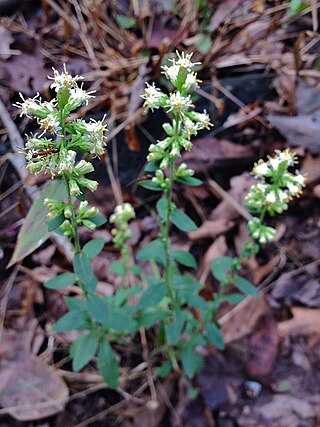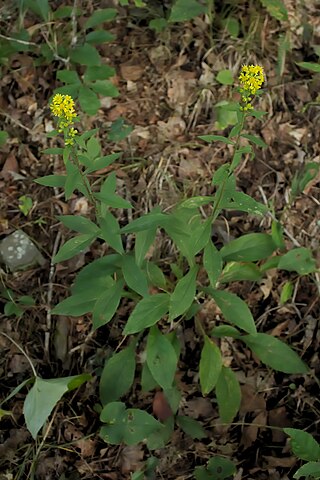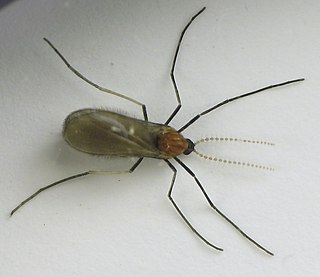
Solidago, commonly called goldenrods, is a genus of about 100 to 120 species of flowering plants in the family Asteraceae. Most are herbaceous perennial species found in open areas such as meadows, prairies, and savannas. They are mostly native to North America, including Mexico; a few species are native to South America and Eurasia. Some American species have also been introduced into Europe and other parts of the world.

Cecidomyiidae is a family of flies known as gall midges or gall gnats. As the name implies, the larvae of most gall midges feed within plant tissue, creating abnormal plant growths called galls. Cecidomyiidae are very fragile small insects usually only 2–3 mm (0.079–0.118 in) in length; many are less than 1 mm (0.039 in) long. They are characterised by hairy wings, unusual in the order Diptera, and have long antennae. Some Cecidomyiids are also known for the strange phenomenon of paedogenesis in which the larval stage reproduces without maturing first. In some species, the daughter larvae consume the mother, while in others, reproduction occurs later on in the egg or pupa.

Solidago canadensis, known as Canada goldenrod or Canadian goldenrod, is an herbaceous perennial plant of the family Asteraceae. It is native to northeastern and north-central North America and often forms colonies of upright growing plants, with many small yellow flowers in a branching inflorescence held above the foliage. It is an invasive plant in other parts of the continent and several areas worldwide, including Europe and Asia. It is grown as an ornamental in flower gardens.

Solidago juncea, the early goldenrod, plume golden-rod, or yellow top, is a North American species of herbaceous perennial plants of the family Asteraceae native to eastern and central Canada and eastern and central United States. It grows from Nova Scotia west to Manitoba and Minnesota south as far as northern Georgia and northern Arkansas, with a few isolated populations in Louisiana and Oklahoma.

Solidago sempervirens, the seaside goldenrod or salt-marsh goldenrod, is a plant species in the genus Solidago of the family Asteraceae. It is native to eastern North America and parts of the Caribbean. It is an introduced species in the Great Lakes region. Similar plants found in the Azores are thought have evolved from a natural introduction of this species.

Solidago nemoralis is a species of flowering plant in the family Asteraceae. It is native to North America, where it is widely found in Canada and the United States. Its common names include gray goldenrod, gray-stem goldenrod, old-field goldenrod, field goldenrod, prairie goldenrod, dwarf goldenrod, and dyersweed goldenrod.

Solidago altissima, the tall goldenrod or late goldenrod, is a North American species of goldenrod in the family Asteraceae which is widespread across much of Canada, the United States, and northern Mexico. It is common in much of its range and fairly tolerant of landscapes which have been disturbed by humans. It has become naturalized in many parts of the world.

Solidago gigantea is a North American plant species in the family Asteraceae. Its common names include tall goldenrod and giant goldenrod, among others.

Solidago velutina, the threenerve goldenrod or velvety goldenrod, is a plant species native to Mexico and to the western United States. The species has been found in southwestern Oregon, east to the Black Hills of South Dakota, and as far south as México State in the central part of the Republic of México. It is classified as a member of Subsection Nemorales.

Solidago bicolor, with several common names including white goldenrod and silverrod, is a plant species native to much of eastern North America. It is found in Canada and in the United States. It prefers sandy and rocky soils, and can frequently be found along roadsides.

Solidago leavenworthii, or Leavenworth's goldenrod, is North American species of herbaceous perennial plants of the family Asteraceae. It is native to southeastern United States from Florida north to Georgia and the Carolinas.

Solidago squarrosa, commonly known as stout goldenrod, is a North American species of goldenrod in the family Asteraceae. It is native to Canada and the eastern United States.

The goldenrod gall fly, also known as the goldenrod ball gallmaker, is a species of fly native to North America. The species is best known for the characteristic galls it forms on several species in the Solidago, or goldenrod, genus. The fly's eggs are inserted near the developing buds of the plant. After hatching, the larvae migrate to an area below the plant's developing buds, where they then induce the plant's tissues to form into the hardened, bulbous chamber referred to as a gall. E. solidaginis’s interactions with its host plant(s) and insect, as well as avian, predators have made it the centerpiece of much ecological and evolutionary biology research, and its tolerance of freezing temperatures has inspired studies into the anti-freeze properties of its biochemistry.

Rhopalomyia anthophilathe Downy Flower Gall Midgeis a species of gall midges, insects in the family Cecidomyiidae. It induces galls on the host Solidago altissima across much of North America.

Rhopalomyia solidaginis, the goldenrod bunch gall, is a species of gall midges, insects in the family Cecidomyiidae The galls of this species have the following host species of goldenrods:Solidago altissima, Solidago canadensis, Solidago rugosa They have been found across eastern North American.

Rhopalomyia lobata is a species of gall midges, insects in the family Cecidomyiidae. The galls form on stems and buds of Euthamia graminifolia the grass-leaved goldenrod. The species ranges from Florida to Mississippi, north to Oregon, New England and most of Canada.

Asphondylia solidaginis is a species of gall midge (Cecidomyiidae) that induces galls on goldenrods in North America where it is widespread. It was first described by William Beutenmuller in 1907.

Rhopalomyia hirtipes is a species of gall midges, insects in the family Cecidomyiidae. They are found in the eastern part of North American on buds and stems of Solidago juncea

Rhopalomyia clarkei is a species of gall midges, insects in the family Cecidomyiidae. The larvae induce galls on two hosts: Solidago altissima and Solidago rugosa and are found in north-eastern and north central North America.
Rhopalomyia thompsoni is a species of gall midges, insects in the family Cecidomyiidae. It induces galls on the host Solidago altissima across much of North America.




















